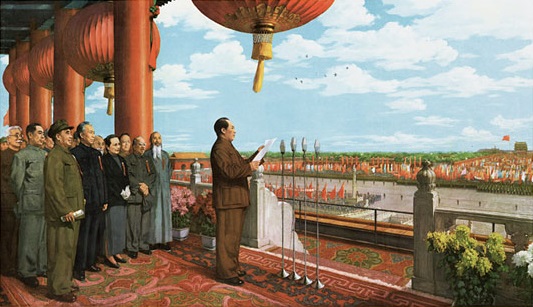What Communist Leader Took Control Of China In 1949

The Communists accept ability 1949
Summary
In 1945 the Americans reinstated Chiang Kai-shek as ruler of China, and tried to organise a truce betwixt Chiang Kai-shek and Mao Zedong, only afterward the give up of Japan a civil state of war bankrupt out, which the Communists won later on a vicious struggle.
In 1949, Mao Zedong proclaimed the China in Beijing, maxim: �China has stood up�, and the Communists too steps to establish a Communist regime.
Links:
The post-obit websites will assistance you consummate the task:
The Ceremonious State of war, 1945-49:
� Map
� Photos
� American documentary
� Frank Smitha
� HA podcast on why Mao achieved a communist revolution in 1949
Proclamation, 1949:
� ChinesePosters.net, including a fascinating history, right at the terminate, of Dong Xiwen's painting
� Picture show footage of the proclamation.
The Ceremonious State of war: causes
a. Extermination Campaigns
The CCP and GMD had been at war, on and off, since the Shanghai massacre of 1927; they were just waiting for peace to begin their war once again
b. Ideologies
The CCP was communist, the GMD was capitalist
c. GMD abuse
In 1945 the Americans reinstated Chiang Kai-shek as ruler of China, but corrupt GMD officials fabricated themselves wealthy past robbing the peasants, and the Secret police hunted downwards opponents of the government
d. Failure of Chongqing Briefing, 1945
The Americans organised a meeting of Mao Zedong and Chiang Kai-shek at Chongqing, merely � although a truce was signed � neither side was prepared to continue it
e. Unofficial war, 1945-46
Afterwards the surrender of Nippon in 1945, and the withdrawal of the Japanese Army, both the CCP and the GMD raced to occupy every bit much of China as possible
The Ceremonious State of war: cardinal events
a. Manchuria, 1945-46
The Soviet Army had occupied Manchuria in 1945; as they pulled out, they cooperated with the CCP to help them motion in
b. Liaoshen Entrada, Sept-Nov 1948
The CCP captured Manchuria
c. Huaihai Campaign, Dec 1948
The CCP surrounded and starved to death the Nationalist ground forces in Hsuchow (160,000 Nationalists died)
d. Pingjin Campaign, January 1949
The CCP captured Beijing
e. Formosa, Dec 1949
Chiang Kai-shek took the government gold reserves and what was left of his army and regime and retreated to Formosa (Taiwan)
Why did the GMD lose the Civil State of war?
a. Communist strengths
i.east. why the Communists won the Civil War
b. �Rot from within�
Chiang Kai-shek believed that the GMD lost because it had become corrupt and inefficient
c. Loss of American support
The Americans gave the GMD $4bn, 1946-48, simply withdrew support during the Berlin Blockade
d. Nationalist Regular army
The morale of the Nationalist Army was very poor
due east. Defections
Many GMD soldiers defected, taking their equipment with them
Why did the Communists win the Civil War?
a. GMD weaknesses
i.e. why the GMD lost the Civil War
b. �Passive defense� tactics
The People's Liberation Army did non attack GMD strongholds, but wore then down with guerrilla raids
c. Peasant support
The Communists mobilised huge numbers of peasants � e.g. 5million during the Huaihai campaign
d. Support from the USSR
The Soviet government gave supplies, advice and aid (particularly in Manchuria, where they allowed the CCP to motion in as they left)
due east. People�due south Liberation Army
The PLA was disciplined, battle-hardened and ideologically-motivated
The establishment of the People�s Republic, 1949
a. Gate of Heavenly Peace, October 1949
Mao Zedong proclaimed the PRC to a oversupply of 300,000 people in Tiananmen Square, Beijing, saying: �Red china has stood up�
b. GMD officials
At first, every bit nigh Communists were peasants, the CCP allowed GMD officials to remain in place
c. Organic Law
The Chinese People�due south Political Consultative Conference (CPPCC) was called in 1949 to organise a constitution for the new authorities of China
d. Common Program, Sep 1949
The CPPCC formed the Common Program, a programme for the gradual change to a communist country, whilst defending China against �imperialism, bullwork and capitalism�
e. Tibet and Xinjiang, 1950
In 1950, the PLA moved into re-institute Chinese power in Tibet and Xinjiang, which had go independent during the Sino-Japanese War
Chore
Report this painting of the declaration of the People's Republic of China 1949 (it will help yous respond question ane if you practice a google epitome search to notice photographs from the event for comparison), and write answers to the questions which follow:
Dong Xiwen, The Founding Anniversary of the Nation, 1964

A propaganda painting of Mao proclaiming the Cathay.
How useful is this source to an historian who wants to larn about the announcement of the PRC in 1949.
Why was this painting produced in 1964?
Explain why the Communists won the Chinese civil war, 1945-49.
What Communist Leader Took Control Of China In 1949,
Source: https://www.johndclare.net/China3.htm
Posted by: obyrnegrops1989.blogspot.com


0 Response to "What Communist Leader Took Control Of China In 1949"
Post a Comment